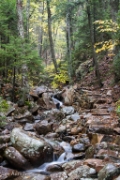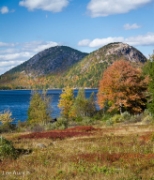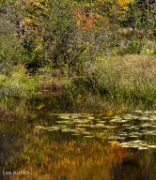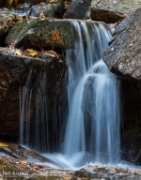
MG 1843
A major portion of the Park is circumnavigated by a one-way road. A mile in, movement beside the road caught my eye. Stopping, I found the first indication that not everything will follow the rules during this trip…
Camera: Canon EOS 7D | Date: 2012.10.10 10:14:10 | ISO: 800 | Exposure: 1/800s | Aperture: ƒ/5.0 | Focal Length: 250mm | Flash: Flash did not fire, auto

MG 8470
An overcast sky is an ugly, brighter-than-anything-else, off-white. The two photographer's general rules are to first, treat the resulting light as gift - it works wonders with flowers, creatures, and objects that benefit from uniform, shadow free lighting. Second, compose pictures that exclude the sky.
My first indication that things might be possible was found on the edge of The Tarn
My first indication that things might be possible was found on the edge of The Tarn
Camera: Canon EOS 40D | Date: 2012.10.10 11:17:44 | ISO: 250 | Exposure: 1/15s | Aperture: ƒ/10.0 | Focal Length: 400mm | Flash: Flash did not fire, auto

MG 1944
Wandering into the Sieur de Monts I found a blaze of muted color - yellows and oranges with a touch of red - so I sought out the combination
Camera: Canon EOS 7D | Date: 2012.10.10 12:29:39 | ISO: 200 | Exposure: 1/60s | Aperture: ƒ/5.0 | Focal Length: 120mm | Flash: Flash did not fire, auto
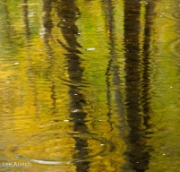
MG 1908
In the foggy, drizzly, overcast gloom, the classic, large groves of highly colored trees were not in evidence so I looked for smaller examples
Camera: Canon EOS 7D | Date: 2012.10.10 11:24:11 | ISO: 250 | Exposure: 1/20s | Aperture: ƒ/5.6 | Focal Length: 85mm | Flash: Flash did not fire, auto
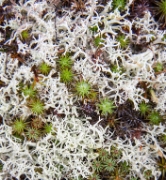
MG 8513
Continuing around the one-way road, I stopped to admire colorful trees. Looking down, I found...
Camera: Canon EOS 40D | Date: 2012.10.10 15:25:21 | ISO: 400 | Exposure: 1/30s | Aperture: ƒ/8.0 | Focal Length: 59mm | Flash: Flash did not fire, auto

MG 8461
Camera: Canon EOS 40D | Date: 2012.10.10 11:07:06 | ISO: 200 | Exposure: 1/6s | Aperture: ƒ/5.6 | Focal Length: 320mm | Flash: Flash did not fire, auto
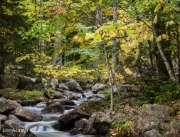
MG 2020
Acadia was established before the era of automobiles; it is threaded with a comprehensive network of carriage roads that weave past the major sites as well as lovely streams and woodlands. These are now shared by rented carriage rides, horsemen, mountain bikes, and dedicated hikers. And a few photographers
Camera: Canon EOS 7D | Date: 2012.10.10 17:19:17 | ISO: 200 | Exposure: 1.3s | Aperture: ƒ/10.0 | Focal Length: 53mm | Flash: Flash did not fire, auto

MG 2012
Camera: Canon EOS 7D | Date: 2012.10.10 17:05:09 | ISO: 200 | Exposure: 1.3s | Aperture: ƒ/10.0 | Focal Length: 85mm | Flash: Flash did not fire, auto
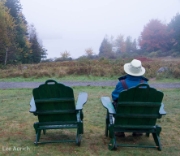
MG 2047
As the first day ended, I relaxed on the lawn in front of the Jordan Pond Restaurant, admiring the pond engulfed in fog
Camera: Canon EOS 7D | Date: 2012.10.10 17:55:23 | ISO: 200 | Exposure: 2.0s | Aperture: ƒ/9.0 | Focal Length: 35mm | Flash: Flash did not fire, auto

MG 3069
Alone among the National Parks, only Acadia has an extensive system of over 50 miles of gravel carriage paths that vastly exceed the number of miles of paved road
Camera: Canon EOS 7D | Date: 2012.10.14 11:36:28 | ISO: 200 | Exposure: 1/10s | Aperture: ƒ/8.0 | Focal Length: 35mm | Flash: Flash did not fire, auto
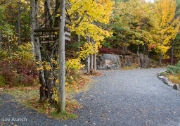
MG 3482
The Carriage Roads were conceived, financed, and construction closely supervised by John D. Rockefeller Jr. as a gift to the park. They reflect a quieter time when the areas that now make up the park elected to ban automobiles from the island.
Wide enough for two carriages to pass (16 feet), the roads weave around the mountains and valleys. The system was carefully designed to provide beautiful perspectives of lakes, vistas, streams, waterfalls, and hillsides. Conveniently, at the center of the system is Jordan Pond with a gracious restaurant serving tea and delightful popovers.
Paths are clearly marked with plenty of signage designed to read by a carriage driver:
Wide enough for two carriages to pass (16 feet), the roads weave around the mountains and valleys. The system was carefully designed to provide beautiful perspectives of lakes, vistas, streams, waterfalls, and hillsides. Conveniently, at the center of the system is Jordan Pond with a gracious restaurant serving tea and delightful popovers.
Paths are clearly marked with plenty of signage designed to read by a carriage driver:
Camera: Canon EOS 7D | Date: 2012.10.16 10:21:06 | ISO: 200 | Exposure: 1/8s | Aperture: ƒ/10.0 | Focal Length: 24mm | Flash: Flash did not fire, auto
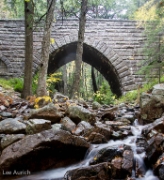
MG 3147
Rockefeller financed 16 of the 17 stone-faced bridges that span streams, waterfalls, roads, and cliff sides. The use of native stone on the exterior gives a rustic look with innards of steel-reinforced concrete - built to last
Camera: Canon EOS 7D | Date: 2012.10.14 13:39:38 | ISO: 200 | Exposure: 1.3s | Aperture: ƒ/8.0 | Focal Length: 18mm | Flash: Flash did not fire, auto
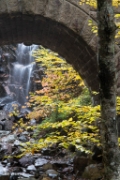
MG 3197
Camera: Canon EOS 7D | Date: 2012.10.14 14:46:40 | ISO: 100 | Exposure: 0.6s | Aperture: ƒ/10.0 | Focal Length: 70mm | Flash: Flash did not fire, auto

MG 3221
Camera: Canon EOS 7D | Date: 2012.10.14 15:05:14 | ISO: 200 | Exposure: 0.3s | Aperture: ƒ/16.0 | Focal Length: 53mm | Flash: Flash did not fire, auto
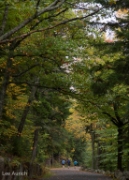
MG 3179
Though there is a small horse-drawn carriage concession, today the roads are largely used by hikers, joggers, bicycles, horses, those seeking seclusion, and a few photographers
Camera: Canon EOS 7D | Date: 2012.10.14 14:32:20 | ISO: 100 | Exposure: 1/30s | Aperture: ƒ/5.6 | Focal Length: 78mm | Flash: Flash did not fire, auto

MG 3809
Mid-morning stroll
Camera: Canon EOS 7D | Date: 2012.10.17 10:26:28 | ISO: 200 | Exposure: 1/6s | Aperture: ƒ/9.0 | Focal Length: 185mm | Flash: Flash did not fire, auto

MG 3418
Beyond the plants, trees, and human sightseers, there was a variety of other life at Acadia. I was able to photograph only a fraction; here are some highlights
Camera: Canon EOS 7D | Date: 2012.10.15 15:44:46 | ISO: 100 | Exposure: 1/10s | Aperture: ƒ/13.0 | Focal Length: 44mm | Flash: Flash did not fire, auto

IMG 3397
The animal core of engineers was widely present in numbers far exceeding my California park experiences. I found recently completed work
Camera: Apple iPhone 4S | Date: 2012.10.13 11:24:04 | ISO: 64 | Exposure: 1/240s | Aperture: ƒ/2.4 | Focal Length: 4mm | Flash: Flash did not fire, auto
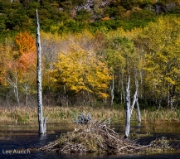
MG 2951
A sample of their lodging
Camera: Canon EOS 7D | Date: 2012.10.13 11:51:13 | ISO: 200 | Exposure: 1/125s | Aperture: ƒ/7.1 | Focal Length: 85mm | Flash: Flash did not fire, auto
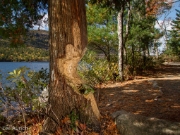
MG 2395
And work-in-progress along one of the heavily walked trails at Jordon Pond
Camera: Canon EOS 7D | Date: 2012.10.11 13:49:24 | ISO: 200 | Exposure: 1/125s | Aperture: ƒ/5.6 | Focal Length: 17mm | Flash: Flash fired

MG 8581
Located along the coast, Acadia had plenty of seagull. This one was perched on the roof of my rental car, intently watching the two women at the next car load their trunk. Brazenly, it stayed put while I opened my trunk, extracted a long lens, closed the trunk, and make its portrait
Camera: Canon EOS 40D | Date: 2012.10.15 13:37:56 | ISO: 200 | Exposure: 1/250s | Aperture: ƒ/10.0 | Focal Length: 400mm | Flash: Flash fired

MG 3586
Acadia is split into several pieces; on one of the western most small pieces known as Pretty Marsh was an incredible field of rolling mounds covered in a liken / moss blanket dotted with fungus
Camera: Canon EOS 7D | Date: 2012.10.16 16:58:58 | ISO: 400 | Exposure: 0.5s | Aperture: ƒ/16.0 | Focal Length: 16mm | Flash: Flash did not fire, auto

MG 3050
All watched over by a host of extraterrestrial stars and potentially worlds
Camera: Canon EOS 7D | Date: 2012.10.13 21:49:10 | ISO: 12800 | Exposure: 25.0s | Aperture: ƒ/3.5 | Focal Length: 10mm | Flash: Flash did not fire, auto
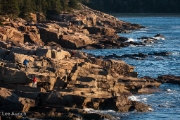
MG 8542
Maine is known for its rugged, rocky, weather-beaten cliffs. One of the classic Maine photos is a rocky coast augmented with a spectacular sunrise.
Acadia National Park has a famous 2-mile stretch of its primary loop road that hugs the cliffs and offers many potential photographic spots. Needless to say, it was swarming with photographers at sunrise
Acadia National Park has a famous 2-mile stretch of its primary loop road that hugs the cliffs and offers many potential photographic spots. Needless to say, it was swarming with photographers at sunrise
Camera: Canon EOS 40D | Date: 2012.10.11 07:12:06 | ISO: 640 | Exposure: 1/250s | Aperture: ƒ/8.0 | Focal Length: 135mm | Flash: Flash did not fire, auto

MG 2096
Unfortunately, mother nature had not received the memo and neglected to provide sufficient clouds to create the "required" effect. I could find interesting patterns in the sky
Camera: Canon EOS 7D | Date: 2012.10.11 06:50:34 | ISO: 200 | Exposure: 1/640s | Aperture: ƒ/9.0 | Focal Length: 135mm | Flash: Flash did not fire, auto

MG 2515
But that was using a long telephoto lens and concentrating on the horizon. Trying to bring in the rocks, and a sea "glow" only produced this
Camera: Canon EOS 7D | Date: 2012.10.12 06:37:51 | ISO: 1250 | Exposure: 1/15s | Aperture: ƒ/10.0 | Focal Length: 17mm | Flash: Flash did not fire, auto
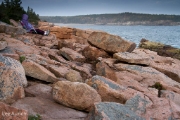
MG 3432
But all is not lost, with the ocean beating, the cliffs still provide a relaxing environment for an afternoon reprise
Camera: Canon EOS 7D | Date: 2012.10.15 16:22:00 | ISO: 100 | Exposure: 1/8s | Aperture: ƒ/11.0 | Focal Length: 35mm | Flash: Flash did not fire, auto

IMG 3388
The other classic Maine coastal photo is a lighthouse - and the Bass Harbor Lighthouse is #1 on the list. An hour before dusk, there were over 50 photographers clinging to the edge of the cliff waiting for the light. But the light never arrived.
Using my iPhone as a camera and a manipulative darkroom, this is the direction of what the photographers wanted, but real life did not provide
Using my iPhone as a camera and a manipulative darkroom, this is the direction of what the photographers wanted, but real life did not provide
Camera: TrueHDR | Date: 2012.10.12 17:50:08 | ISO: 64 | Exposure: 1/25s | Aperture: ƒ/2.4 | Focal Length: 4mm | Flash: Flash did not fire, auto
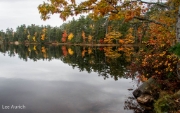
MG 3568
I love reflections. Calm water, an interesting subject, good light, and I am near heaven. This email is a collection of some of my favorites from Acadia National Park.
Reflections come in many forms. Symmetry requires beautifully still water similar to this scene at Somes Pond that I stumbled across when I took a wrong turn looking for Pretty Marsh
Reflections come in many forms. Symmetry requires beautifully still water similar to this scene at Somes Pond that I stumbled across when I took a wrong turn looking for Pretty Marsh
Camera: Canon EOS 7D | Date: 2012.10.16 16:05:00 | ISO: 200 | Exposure: 1/13s | Aperture: ƒ/11.0 | Focal Length: 17mm | Flash: Flash did not fire, auto
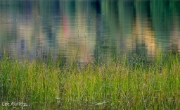
MG 2473
Or a reflection may be a mediation on the light itself, implying the source. This is late afternoon, close to sunset
Camera: Canon EOS 7D | Date: 2012.10.11 17:31:26 | ISO: 200 | Exposure: 0.4s | Aperture: ƒ/11.0 | Focal Length: 115mm | Flash: Flash did not fire, auto
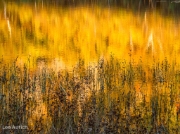
MG 3727
Colors vary with the source and quality of the light as shown in the reflections from trees receiving their first, gentle light as the sun emerged above the trees behind me at a pond along Schooner Head Road that I saw out of the corner of my eye as I returned from an unremarkable coastal sunrise
Camera: Canon EOS 7D | Date: 2012.10.17 07:15:51 | ISO: 200 | Exposure: 1/50s | Aperture: ƒ/9.0 | Focal Length: 80mm | Flash: Flash did not fire, auto
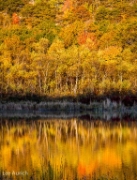
MG 3741
As the sun rose further, its warmth stirred the air, a breeze intensified, and the relative stillness of the pond departed. Just before the reflections were washed away in the ripples, I caught this view of the same pond, a few minutes later
Camera: Canon EOS 7D | Date: 2012.10.17 07:22:04 | ISO: 200 | Exposure: 1/60s | Aperture: ƒ/9.0 | Focal Length: 72mm | Flash: Flash did not fire, auto

MG 2472
Reflections can be mirror like images
Camera: Canon EOS 7D | Date: 2012.10.11 17:30:03 | ISO: 200 | Exposure: 1/15s | Aperture: ƒ/11.0 | Focal Length: 190mm | Flash: Flash did not fire, auto
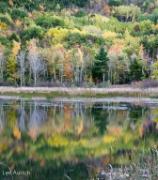
MG 3028
A few minutes later, with a telephoto lens to focus on the trees
Camera: Canon EOS 7D | Date: 2012.10.13 17:35:27 | ISO: 200 | Exposure: 0.5s | Aperture: ƒ/8.0 | Focal Length: 56mm | Flash: Flash did not fire, auto
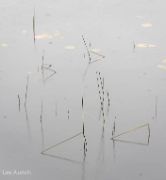
MG 3495
Witch Hole Pond, along a carriage road, in a pause in the rain in a completely overcast, gray day
Camera: Canon EOS 7D | Date: 2012.10.16 10:43:37 | ISO: 200 | Exposure: 1/6s | Aperture: ƒ/11.0 | Focal Length: 72mm | Flash: Flash did not fire, auto
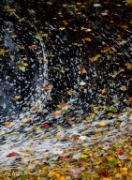
MG 3552
First, my favorite from the trip in the category what is it? Pond swirls
Camera: Canon EOS 7D | Date: 2012.10.16 15:41:34 | ISO: 200 | Exposure: 1/60s | Aperture: ƒ/5.6 | Focal Length: 85mm | Flash: Flash did not fire, auto

MG 2292
Proof that Acadia does have clouds that would have made great sunrises and sunsets had the clouds not evaporated by the ends of the day (looking west from Cadillac Mountain across Eagle Lake 3 hours after sunrise)
Camera: Canon EOS 7D | Date: 2012.10.11 10:13:38 | ISO: 640 | Exposure: 1/500s | Aperture: ƒ/9.0 | Focal Length: 17mm | Flash: Flash did not fire, auto

IMG 3346
Looking southeast from the summit of Cadillac Mountain; an iPhone image using my clip-on sunglasses as a polarizing filter
Camera: TrueHDR | Date: 2012.10.11 11:13:06 | ISO: 64 | Exposure: 1/200s | Aperture: ƒ/2.4 | Focal Length: 4mm | Flash: Flash did not fire, auto

MG 3002
My favorite small stream at the entrance to the Kane Path
Camera: Canon EOS 7D | Date: 2012.10.13 12:47:29 | ISO: 200 | Exposure: 1.0s | Aperture: ƒ/16.0 | Focal Length: 28mm | Flash: Flash did not fire, auto
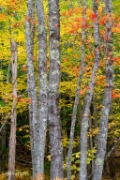
MG 2576
Finally, a burst of color because I grew up in Los Angeles where fall foliage is a foreign term. In LA, the leaves slowly turn brown over the course of the winter and then are pushed off the trees by the new leaves in the spring. The concept of fall foliage was a odd as snow -- something one goes to, rather than something that comes to you
Camera: Canon EOS 7D | Date: 2012.10.12 09:13:16 | ISO: 200 | Exposure: 1.6s | Aperture: ƒ/18.0 | Focal Length: 70mm | Flash: Flash did not fire, auto

MG 3308
Camera: Canon EOS 7D | Date: 2012.10.15 09:47:52 | ISO: 400 | Exposure: 1/160s | Aperture: ƒ/13.0 | Focal Length: 38mm | Flash: Flash did not fire, auto
© Lee Aurich



